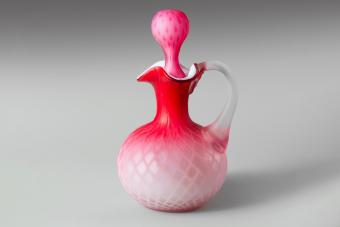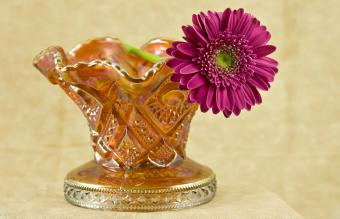
Cruets, not to be confused with croquet, croquettes, or any other uniquely indiscernible word, aren't a kind of virus you don't want to get. Instead, they're one of the most useful and elegant ways people have been storing their vinegar and oil for years. In some cultures, mothers pass down their cruet sets to their children just like some pass down special recipes, and others, seasoned cast iron skillets. Since these antique cruet sets are often hidden in plain sight, you might be using one to store your syrup or similarly silly ingredient instead of giving these valuable kitchen tools their due.
What Are Cruet Sets?
A cruet is a flat-bottomed container with a spout and narrow neck that's closed using a stopper. Typically, they come with handles (though not all do), and are used to hold liquid ingredients like olive oil and vinegar. It's believed that the first cruets popped up in the 17th century to hold granular ingredients, rather than liquid ones.
How Cruet Styles Have Changed Over Time

Initially, cruets were exclusive to rich households that had stores of ingredients and spices. Medieval peasants didn't just have gold or silver kitchen tools lying around. Yet, cruets trickled down to the working class, as so many products do, by the 18th and 19th centuries. Unfortunately, the stranglehold cruets had on domestic kitchens everywhere waned in the 1920s, and having them as a standard part of your table setup fell out of fashion.
So, cruets are typically a bit on the older side and come in a wide variety of colors, designs, and styles. If you spend hours picking out the dinnerware for your dining room, then it's only natural that you'd do the same for the containers your guests will use.
Antique Cruet Styles to Look For

Antique cruet sets were originally crafted out of precious metals like silver and gold because they were made for the upper stratospheres of Medieval high society. As they became more available to the public, but were still hand-crafted, they were also made from other materials like crystal and ceramic. Cut-glass was a big favorite in the 18th century, where glassmakers could create all sorts of geometric designs and storybook motifs across their work.
Naturally, colored glass cruets started showing up in the mid-19th century when vibrant color was all the rage. You could find them in deep blues and bright reds, especially. Mass-manufacturing at the end of the 19th century made cruets available for just about anyone who wanted to buy them, leaving the upper crust to define their wealth not by the tools themselves but by the materials they had them made out of. Think silver and gold, again.
How Much Are Antique Cruet Sets Worth?
Just because something is old doesn't mean it's automatically worth a lot of money. Cruet sets were such a popular fixture in historic kitchens that there are a ton of them for sale. Since you can find an abundance of them, it'll take a little more to make a set worth something.
Typically, crystal sets are the most common that you'll find, and they're worth about $10-$30. The larger the set, the more valuable it is. Additionally, keep your eyes peeled for any sets with silver hallmarks or gold stamps, as these are worth more thanks to the metal alone. For these decorative and expensive cruet sets, you're looking at prices in the $50-$500 range.
For example, this Victorian cruet set featuring five crystal bottles and a silver-plate stand is marked Racine SP. Co. Rockford SP. Being stamped and having silver marks makes this set more valuable than your average cut-glass one, as it sold for $55.
In comparison, a much rarer Victorian set sold for $295.95. Made out cranberry glass (which is highly collectible) and accented with silver stoppers, it's no wonder this set sold for so much higher than the average range.
Is It Safe to Use Antique Cruet Sets?
It's okay to be wary about using something that's going to be touching ingredients you plan to ingest. Unlike some Pyrex and casserole dishes that are embroiled in controversy over how dangerous they are to cook food in, old cruet sets are safe to use. However, that doesn't mean you can pick up a cruet set at a vintage store and immediately pour your artisanal olive oil in it. There are a few things you need to check first before using them.
Look in the bottom of the cruet. If the bottles are too narrow to get a bottle brush inside, then soaking a dirty cruet might not be enough to fully clean it. And since you don't know exactly what's growing in there, it's a good idea to leave those for decoration only.
Clean Your Antique Cruet Sets Carefully
Similarly, you should always clean any old cutlery or kitchenware before using it. A simple warm water and soap solution should do the trick, but be careful about handling your antiques, since crystal isn't going to hold up if it slips out of your sudsy hands. We don't recommend you putting these in the dishwasher, though. Stick to hand washing and drying.
Make Every Meal a Fancy Affair
As time passes, society becomes less strict about upholding rules and manners, and you can see this leniency in the way we prepare meals today. Gone are the days where we washed out napkins and had bowls and dishes for every kind of meal prep. Yet, if you're longing for a little elegance in your everyday life, finding a cheap antique cruet set to store your olive oil and vinegar instead of the same square bottles they sell at every home goods store should make the top of your weekend to-do list.







